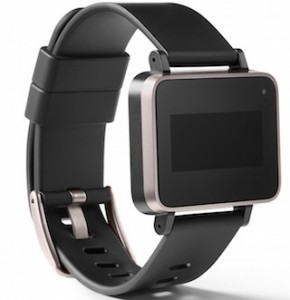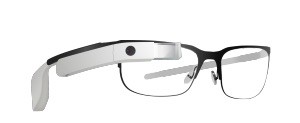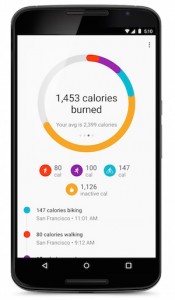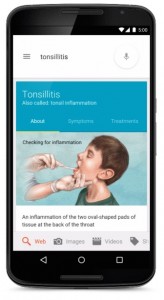 At the end of 2013 MobiHealthNews published a long post called "Checking up on Dr. Google: How the search giant has tackled health and wellness" that looked at the history of Google's health moves, going all the way back to 2008 with Google Flu Trends and the failed Google Health PHR. Since we wrote that post, the company has launched nearly as many new health-related initiatives as it had in the five years between 2008 and 2013, and at least one of the newer ones from two years ago is now out of the picture -- Google Helpouts, which was just getting off the ground when we wrote that roundup, has since been shuttered because of a lack of interest.
At the end of 2013 MobiHealthNews published a long post called "Checking up on Dr. Google: How the search giant has tackled health and wellness" that looked at the history of Google's health moves, going all the way back to 2008 with Google Flu Trends and the failed Google Health PHR. Since we wrote that post, the company has launched nearly as many new health-related initiatives as it had in the five years between 2008 and 2013, and at least one of the newer ones from two years ago is now out of the picture -- Google Helpouts, which was just getting off the ground when we wrote that roundup, has since been shuttered because of a lack of interest.
One big operation that's emerged in the meantime is Google Fit, a fitness data aggregator that plays more or less in the same space as Apple's HealthKit. And Google Glass, which got a brief mention back then, now has some real health bonafides under its belt. But for the most part, Google's health efforts post-2013 have fallen under the life sciences group at Google X, the company's moonshot research wing. News has trickled out in the last two years about six different health-related ventures at Google X that we'll dive into below. Read on for an updated check-up on the tech titan's latest health efforts.
Google Glass
 In January, Google made a controversial announcement about Google Glass: the Explorer program (by which consumers were able to get access to the devices) was shutting down. In addition, Google Glass would move out of Google’s experimental Google X Lab to become their own Google Team, under Nest creator Tony Fadell. Though many in the media were ready to declare Google Glass dead, for the healthcare space (and enterprise in general) reports of Glass’s death were greatly exaggerated. Augmedix and Pristine, two companies working on Glass applications in healthcare, said they were bullish about Glass’s future.
In January, Google made a controversial announcement about Google Glass: the Explorer program (by which consumers were able to get access to the devices) was shutting down. In addition, Google Glass would move out of Google’s experimental Google X Lab to become their own Google Team, under Nest creator Tony Fadell. Though many in the media were ready to declare Google Glass dead, for the healthcare space (and enterprise in general) reports of Glass’s death were greatly exaggerated. Augmedix and Pristine, two companies working on Glass applications in healthcare, said they were bullish about Glass’s future.
And just a month later we saw some validation of that optimism. After two and half years of negotiations with Google and with the Illinois Department of Public Health, a Skokie, Illinois ambulance service rolled out a program to give doctors live access to paramedics’ points of view via Google Glass. The Medical Express Ambulance Service, or MedEx for short, uses software developed by Pristine and is working with The Advocate Illinois Masonic Medical Center in Chicago at first, but plans to expand into additional hospitals in the future.
Then in April, a feasibility study published in JAMA dermatology showed that patients are overwhelmingly satisfied with dermatology consults via Google Glass, even preferring them to consultations over the phone. Twenty-nine of the patients 31 patients in the study (93.5 percent) were satisfied overall with the procedure and 30 (96.8 percent) were confident in both the accuracy of the video equipment and the privacy of their information. Twenty-eight people said they would recommend the Google Glass consultation to others.
We've covered doctors and surgeons using Glass in a variety of ways -- as a heads up display to access patient records during treatments, as a training device for medical students, and as a telemedicine device, to do remote consults with stroke specialists or dermatologists. It's shown up in a pilot capacity in Rhode Island Hospital, Beth Israel Deaconess Hospital, UC Irvine, Stanford, and Harvard, to name a few. Although it's far from mainstream, Glass has proven it has healthcare potential. Time will tell if it has real stickiness in the OR.
Google Fit
 Google announced its data aggregation platform Google Fit in summer 2014, just a few weeks after Apple announced its HealthKit platform for iOS 8. While Apple’s Health app can integrate with — not only wellness tracking apps — but also apps for connected medical devices like glucometers and medication adherence apps, Google Fit is focused squarely on fitness. Similar to Samsung’s SAMI platform, Google Fit provides developers with a single set of APIs so that different apps and devices can talk to each other and users can get more context from their various, disparate fitness metrics.
Google announced its data aggregation platform Google Fit in summer 2014, just a few weeks after Apple announced its HealthKit platform for iOS 8. While Apple’s Health app can integrate with — not only wellness tracking apps — but also apps for connected medical devices like glucometers and medication adherence apps, Google Fit is focused squarely on fitness. Similar to Samsung’s SAMI platform, Google Fit provides developers with a single set of APIs so that different apps and devices can talk to each other and users can get more context from their various, disparate fitness metrics.
In May, Google added a number of new fitness features in a new update. Specifically, the update added the ability to track calories burned and distance traveled, provided the user enters their gender, height and weight in the app. Surprisingly, prior to this update, Google Fit only natively tracked steps and time spent walking, running or biking. It depended on third-party apps to track other metrics. The new update also added a historical view, which the app didn’t have before.
Google Fit works with various companies that offer digital health apps and devices including LG, RunKeeper, Polar, Basis, Motorola, MapMyFitness, Asus, Noom, Withings, Adidas, Azumio, Basis and — somewhat surprisingly — even Nike, which has had a longterm relationship with Apple and took a while to launch an Android app. Notably, neither Fitbit nor Jawbone has chosen to integrate with Google Fit yet.
So far, unlike Apple HealthKit, Google Fit has not officially made its way into any kind of clinical setting, although Duke University's Dr. Ricky Bloomfield said at an event last year that he'd be very interested in Google getting to the point where such an integration is possible.
"I think Google needs to do a little bit more to get it into the place where HealthKit currently functions, but I can’t wait until we can use Android devices as well as iOS devices, one to the other,” Bloomfield said at the time. “For me the most important thing is we give this ability to our patients. And I don’t care which device they have, I just want them to be able to give us the data so we can make good clinical decisions to help them out.”
Google Health Searches with Knowledge Graph
 We wrote a lot last time around about Google's constant improvement of what comes up when users do a search for a health-related topic. That trend has continued, with the introduction of health content vetted by doctors at Google and the Mayo Clinic.
We wrote a lot last time around about Google's constant improvement of what comes up when users do a search for a health-related topic. That trend has continued, with the introduction of health content vetted by doctors at Google and the Mayo Clinic.
“We’ll show you typical symptoms and treatments, as well as details on how common the condition is -- whether it’s critical, if it’s contagious, what ages it affects, and more,” product manager Prem Ramaswami wrote on the Google Blog at the time. “For some conditions you’ll also see high-quality illustrations from licensed medical illustrators. Once you get this basic info from Google, you should find it easier to do more research on other sites around the web, or know what questions to ask your doctor.”
Knowledge Graph is a function of Google Search, introduced in 2012, that combines Google’s search algorithm with publicly available and internal databases to create a “smarter” search. With Knowledge Graph, a small display of relevant information shows up at the top of a user’s search results page. Google first started using Knowledge Graph with health-related search results in 2012. The information Knowledge Graph will display is gathered from well-regarded medical websites has been vetted by a team of doctors, both internal at Google, led by Dr. Kapil Parakh, and at the Mayo Clinic.
“That doesn’t mean these search results are intended as medical advice,” Ramaswami added. “We know that cases can vary in severity from person to person, and that there are bound to be exceptions. What we present is intended for informational purposes only -- and you should always consult a healthcare professional if you have a medical concern.”
The Google-Novartis Smart Contact Lens
 Google's in-progress contact lens.
Google's in-progress contact lens.
In January of 2014, Google officially announced its intentions to develop smart contact lenses, as a noninvasive method of measuring blood glucose levels in people with diabetes. The contact lens, a project from Google X's life sciences group, is comprised of a miniaturized glucose sensor and wireless chip embedded between two layers of contact lens material, although the researchers add that eventually it might have tiny LED lights that would act as an early warning when glucose levels have dropped or risen past certain thresholds.
Although the lens was met with some early skepticism, and even Google warned that it was looking at a five-plus year timetable, Google was able to find a high-profile partner to commercialize the technology: Alcon, a subsidiary of Novartis.
In an announcement published one year ago on Novartis’ website, the pharma company actually mentions two use cases for the smart lenses. Noninvasive glucose monitoring (via tears) for people with diabetes was one. That’s the use case about which Google met with the FDA last year. The other was for people with corrective vision needs.
“For people living with presbyopia who can no longer read without glasses, the ‘smart lens’ has the potential to provide accommodative vision correction to help restore the eye’s natural autofocus on near objects in the form of an accommodative contact lens or intraocular lens as part of the refractive cataract treatment,” the statement says.
We haven't heard anything about the contact lens in a while, but a Google spokesperson told MobiHealthNews that the project is still in the works.
The Google Baseline Study (and the Biogen MS study)
About a year ago, the Wall Street Journal broke the news of the Google Baseline study, which will use a combination of genetic testing and digital health sensors to collect “baseline” data on healthy people. The idea is to establish genetic biomarkers relating to “how [patients] metabolize food, nutrients and drugs, how fast their hearts beat under stress and how chemical reactions change the behavior of their genes.”
The study started with 175 patients at Duke University and Stanford university. It takes full advantage of some relatively recent developments: the current, relatively low price of sequencing a genome and the capacity of digital health sensors to collect 24/7 real-world health data. Because of these two advancements, Google is able to create a healthcare study focused solely on well patients, which could produce data on the nuances of the human body’s normal functionality that doctors have never had before.
In June, Google began to test the first app that could be used in the wider rollout of its Google Baseline study, called the Study Kit app.
“We are in the early stages of designing the Baseline Study and are exploring ways to make it easy for participants to share their health information and habits with researchers on a routine basis,” a Google spokesperson told MobiHealthNews in an email. “An app is one route we’re considering and some of our pilot participants are testing this early version.”
Separate from the Baseline Study, the Google X life sciences group is also working with Biogen Idec on a project to study outside factors that could contribute to multiple sclerosis. Google and Biogen will use sensors, software, and data analysis tools to collect and analyze data from people who have MS. The companies aim to explore why MS progresses differently in each patient.
Lift Labs
 Last fall, Google acquired San Francisco-based Lift Labs, a company that is developing smart utensils for people with Parkinson’s and essential tremor. Lift Labs now operates as part of the Google X Life Sciences group.
Last fall, Google acquired San Francisco-based Lift Labs, a company that is developing smart utensils for people with Parkinson’s and essential tremor. Lift Labs now operates as part of the Google X Life Sciences group.
“[Lift Labs’] tremor-canceling device could improve quality of life for millions of people,” Google wrote on its Google+ account at the time of the acquisition. “We’re also going to explore how their technology could be used in other ways to improve the understanding and management of neurodegenerative diseases such as Parkinson’s disease and essential tremor.”
In its own statement, Lift Labs said that it will continue to sell its Liftware system and will use Google’s resources to reach more people who have Parkinson’s or essential tremor. So far the company has made a spoon that will cancel tremors while the user is eating, but the company plans to add other utensils like a fork and knife. While the technology does not work on people whose tremors are too extreme or in the whole arm, the company is in the process of designing a product to suit this group.
Cancer-scanning Nanoparticle Pill
Google announced in October that its life sciences group is developing a smart pill that could scan for cancer and send the results to a user’s wearable sensor device. The pill, which is in the early stages of research, is packed with tiny magnetic particles that can go looking for malignant cells in the bloodstream and report findings to a wearable device. The team working on the system reportedly consists of doctors, including an oncologist, electrical and mechanical engineers, and an astrophysicist. The sensor’s potential isn’t limited to cancer: it could be used to detect early risk factors for heart disease or kidney disease, for example.
Head researcher Andrew Conrad said in an interview in November that the project is years, not decades, away from completion, and that Google will embark on the first human tests of the nanoparticle technology with a clinical partner. They're already working with MIT and Stanford on various aspects of it. The project will also likely intersect with the Baseline study.
“We’ve done a lot, to be quite humble about it,” Conrad told BackChannel at the time. “Enough to give us great confidence that this is all likely to work. At our Google facilities, we’ve been able to build the nanoparticles, decorate them, prove that they bind to the things that we want them to bind to, in really clever artificial systems. We’ve made these molded arms where we pump fake blood through them and then try devices to detect the nanoparticles. We’re pretty good at concentrating and detecting nanoparticles. We’re pretty good at making sure that those particles bind only to cancer cells and not to other cells.”
Google Genomics
Last March Google quietly launched Google Genomics, an initiative that's courting researchers in an effort to store human genome data for them in a secure cloud for $25 per year. The reason Google Genomics could be a big deal is that most of the value in even having human genomic data comes from being able to compare ever-larger sets of genomes.
Google wants to create one giant genomic database, such that, in the words of Deniz Kural, CEO of genome sequencing company Seven Bridges who spoke to the MIT Technology Review, “if I were to get lung cancer in the future, doctors are going to sequence my genome and my tumor’s genome, and then query them against a database of 50 million other genomes. The result will be ‘Hey, here’s the drug that will work best for you.’”
Google isn’t the only one working on this project: Amazon is too, and a number of smaller players are lining up behind both databases. As of last fall, Google already had at least 3,500 genomes from public projects on its servers and could have more from private projects.
Google's Clinical Wearable
Just recently, the Google X life sciences team announced that it’s building a wearable health sensor for cardiac and activity tracking. Google’s device is a clinical-grade sensor designed for investigational use. The wristworn sensor will measure pulse, activity level, and skin temperature continuously. It will also be able to take an ECG and pick up on environmental information like light and noise levels, which might indicate to investigators that a person isn’t wearing the device or isn’t leaving their house much. Google will investigate different research cases for the device, including sending it home with discharged patients at risk for readmission. The device may or may not be used in the Baseline study.













